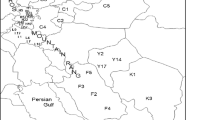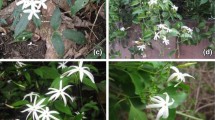Abstract
There are many species of jasmines in different regions of Iran in natural or cultivated form, and there is no information about their genetic status. Therefore, inter-simple sequence repeat (ISSR) analysis was used to evaluate genetic variations of the 53 accessions representing eight species of Jasminum collected from different regions of Iran. A total of 21 ISSR primers were used which generated 981 bands of different sizes. Mean percentage of polymorphic bands was 90.64 %. Maximum resolving power, polymorphic information content average, and marker index values were 21.55, 0.35, and 14.42 for primers of 3, 4, and 3 respectively. The unweighted pair group method with arithmetic mean dendrogram based on Jaccard’s coefficients indicated that 53 accessions were divided into two major clusters. The first major cluster was divided into two subclusters; the subcluster A included Jasminum grandiflorum L., J. officinale L., and J. azoricum L. and the subcluster B consisted of three forms of J. sambac L. (single, semi-double, and double flowers). The second major cluster was divided into two subclusters; the first subcluster (C) included J. humile L., J. primulinum Hemsl., J. nudiflorum Lindl. and the second subcluster (D) consisted of J. fruticans L. At the species level, the highest percentage of polymorphism (34.05 %), numbers of effective alleles (1.16), Shannon index (0.151), and Nei’s genetic diversity (0.098) were observed in J. officinale. The lowest values of percentage polymorphism (0.011), number of effective alleles (1.009), Shannon index (0.007), and Nei’s genetic diversity (0.005) were obtained for J. nudiflorum. Based on pairwise population matrix of Nei’s unbiased genetic identity, the highest identity (0.85) was found between J.officinale and J. azoricum and the lowest identity (0.69) was between J. grandiflorum and J. perimulinum. Based on analysis of molecular variance, the amount of genetic variations among the eight populations was 83 %. This study demonstrated that the ISSR is an useful tool in jasmine genomic diversity studies and to detect their relationships.



Similar content being viewed by others
References
Sabeti, H. (2006). Forests, trees and shrubs of Iran (p. 874). Iran: Yazd University Publication. in Farsi.
Dickey, R.D. (1970). In E. A. Meninger (Ed.), Flowering vines of the world (p. 410). New York: Heartside Press Inc.
Vijayakumar, M., Arumugum, T., Jawaharlal, M., & Bhattacharjee, S. K. (2006). Jasmine. In S. K. Bhattacharjee (Ed.), Advances in ornamental horticulture (Vol. 1, pp. 84–114). Jaipur: Pointer Publishers.
Anonymous (2011). United States Department of Agriculture (USDA). Species records of Jasminum. ARS, national genetic resources program. germplasm resources information network (GRIN) Retrieved 17th May, 2009. http://www.ars-grin.gov/cgi-bin/npgs/html/taxon.pl/407300.
Green, P., & Miller, D. (2009). The genus Jasminum in cultivation (pp. 110–113). Kew: Kew Publishing, Royal Botanic Gardens.
Abdoul-Latif, F., Edou, P., Eba, F., Mohamed, N., Ali, A., Djama, S., et al. (2010). Antimicrobial and antioxidant activities of essential oil and methanol extract of Jasminum sambac from Djibouti. African Journal of Plant Science, 4, 38–43.
Qian, W., Ge, S., & Houng, D. Y. (2001). Genetic variation within and among populations of a wild rice Oryza granulata from China detected by RAPD and ISSR markers. Theoretical and Applied Genetics., 102, 440–449.
Bolaric, S., Barth, S., Melchinger, A. E., & Posselt, U. K. (2005). Genetic diversity in European perennial ryegrass cultivars investigated with RAPD markers. Plant Breed, 124, 161–166.
Pivorienė, O., & Pašakinskienė, I. (2008). Genetic diversity assessment in perennial ryegrass and Festulolium by ISSR fingerprinting. Zemdirbyste, 95, 125–133.
Brickell, C. (2003). A–Z encyclopedia of garden plants (p. 1128). London: Dorling Kindersley Limited.
Hooker, J. D. (1882). Flora of British India (Vol. 3). London: L. Reeve and Co.
Engler, A., Prantl, K. (1897). Die Naturlichen Pflanzen Familien, IV. Teil, Leizpig. * Original not seen.
Gamble, J. S. (1923). Flora of the presidency of Madras, Part V (pp. 785–791). London: Adlard and Son.
Mahmood, M. A., Hafiz, I. A., Abbasi, N. A., & Faheem, M. (2013). Detection of genetic diversity in Jasminum species through RAPD techniques. International Journal of Agriculture and Biology, 15, 505–510.
Shekhar, S., Sriram, S., & Prasad, M. P. (2013). Genetic diversity determination of jasmine species by DNA fingerprinting using molecular markers. International Journal of Biotechnology and Bioengineering Research, 4, 335–340.
McCough, S. R., Chen, X., Panaud, O., Temnykh, S., Xu, Y., Cho, Y. G., et al. (1997). Microsatellite marker development, mapping and applications in rice genetics and breeding. Plant Molecular Biology, 35, 89–99.
Mitchell, S. E., Kresovich, S., & Jester, C. A. (1997). Application of multiplex PCR and fluorescence-based, semi-automated allele sizing technology for genotyping plant genetic resources. Crop Science, 37, 617–624.
Estoup, A., & Angers, B. (1998). Microsatellites and minisatellites for molecular ecology: Theoretical and empirical considerations. In G. R. Carvalho (Ed.), Advances in molecular ecology nato sciences series (pp. 55–86). Amsterdam: IOS Press.
Zietkiewicz, E., Rafalski, A., & Labuda, D. (1994). Genome fingerprinting by simple sequence repeat (SSR)-anchored polymerase chain reaction amplification. Genomics, 20, 176–183.
Shi, A., Kantartzi, S., Mmbaga, M., & Chen, P. (2010). Development of ISSR PCR markers for diversity study in dogwood (Cornus spp.). Agriculture and Biology Journal of North America, 1, 189–194.
Pharmawati, M., Yan, G., & McFarlane, I. J. (2004). Application of RAPD and ISSR markers to analyze molecular relationships in Grevillea (Proteaceae). Australian Systematic Botany, 17, 49–61.
Fang, D. Q., Roose, M. L., Krueger, R. R., & Federici, C. T. (1997). Fingerprinting trifoliate orange germplasm accessions with isozymes, RFLPs, and inter-simple sequences repeat markers. Theoretical and Applied Genetics, 95, 211–219.
Van der Nest, M. A., Steenkamp, E. T., Wingfield, B. D., & Wingfield, M. J. (2000). Development of simple sequence repeat (SSR) markers in Eucalyptus from amplified inter-simple sequence repeats (ISSR). Plant Breeding, 119, 433–436.
Raina, S. N., Rani, V., Kojima, T., Ogihara, Y., Singh, K. P., & Devarumath, R. M. (2001). RAPD and ISSR fingerprints as useful genetic markers for analysis of genetic diversity, varietal identification, and phylogenetic relationships in peanut (Arachis hypogaea) cultivars and wild species. Genome, 44, 763–772.
Patzak, J. (2001). Comparison of RAPD, STS, ISSR and AFLP molecular methods used for assessment of genetic diversity in hop (Humulus lupulus L.). Euphytica, 121, 9–18.
Ge, X. J., Yu, Y., Zhao, N. X., Chen, H. S., & Qi, W. Q. (2003). Genetic variation in the endangered inner magnolia endemic shrub Tetraena mongolica Maxim. (zygophyllacceae). Biological Conservation, 111, 427–434.
Archak, S., Gaikwad, A. B., Gautam, D., Rao, E. V. V. B., Swamy, K. R. M., & Karihaloo, J. L. (2003). DNA finger-printing of Indian cashew (Anacardium occidentalle) varieties using RAPD and ISSR techniques. Euphytica, 230, 397–404.
Monforte, A. J., Garcia-Mas, J., & Arús, P. (2003). Genetic variability in melon based on microsatellite variation. Plant Breeding, 122, 153–157.
Adams, R. P., Schwarzbach, A. H., & Pandcy, R. N. (2003). The concordance of terpenoid, ISSR and RAPD markers, and its sequence data sets among genotypes an example from Juniperus. Biochemical Systematics and Ecology, 31, 325–381.
Salehi, M., Salehi, H., Niazi, A., & Ghobadi, C. (2014). Convergence of goals: Phylogenetical, morphological, and physiological characterization of tolerance to drought stress in tall fescue (Festuca arundinacea Schreb.). Molecular Biotechnology, 56, 248–257.
Joshi, S. P., Gupta, V. S., Aggarwal, R. K., Ranjekar, P. K., & Brar, D. S. (2000). Genetic diversity and phylogenetic relationships as revealed by inter simple sequence repeat (ISSR) polymorphism in the genus Oryza. Theoretical and Applied Genetics, 100, 1311–1320.
Kochieva, E. Z., Ryzhova, N. N., Khrapalova, I. A., & Pukhalskyi, V. A. (2002). Genetic diversity and phylogenetic relationships in the genus Lycopersicon (Tourn.) mill. as revealed by inter-simple sequence repeat (ISSR) analysis. Russian Journal of Genetics, 38, 958–966.
Iruela, M., Rubio, J., Cubero, J. I., Gil, J., & Millan, T. (2002). Phylogenetic analysis in the genus Cicer and cultivated chickpea using RAPD and ISSR markers. Theoretical and Applied Genetics, 104, 643–651.
Rzepka-Plevneš, D., Smolik, M., & Tańska, K. (2006). Genetic similarity of chosen Syringa species determined by the ISSR-PCR technique. Dendrobiology, 56, 61–67.
Jonavicene, K., Paplauskiene, V., & Brazauskas, G. (2009). Isozymes and ISSR markers as a tool for the assessment of genetic diversity in Phleum spp. Zemdirbyste, 96, 47–57.
Doyle, J. J., & Doyle, J. L. (1990). Isolation of plant DNA from fresh tissue. Focus, 12, 13–15.
Noormohammadi, Z., Samadi-Molayousefi, H., & Sheidai, M. (2012). Intra-specific genetic diversity in wild olives (Olea europaea ssp. cuspidata) in Hormozgan Province, Iran. Genetics and Molecular Research, 11, 707–716.
Mantel, N. (1967). The detection of disease clustering and a generalized regression approach. Cancer Research, 27, 209–220.
Rohlf, F. J. (1998). NTSYSpc: Numerical taxonomy and multivar-iate analysis system. Version 2.02. New York: Exeter Publications.
Gilbert, J. E., Lewis, R. V., Wilkinson, M. J., & Caligari, P. D. S. (1999). Developing an appropriate strategy to assess genetic variability in plant germplasm collections. Theoretical and Applied Genetics, 98, 1125–1131.
Powell, W., Morgante, M., Andre, C., Hanafey, M., Vogel, J., Tingey, S., et al. (1996). The comparison of RFLP, RAPD, AFLP, and SSR (microsatellite) markers for germplasm analysis. Molecular Breeding, 2, 225–238.
Weising, K., Nybon, H., Wolff, K., & Kahl, G. (2005). Applications of DNA fingerprinting in plant sciences. In Taylor & Francis (Ed.), DNA fingerprinting in plants. principles, methods and applications (2nd ed., pp. 235–276). London: CRC Press Boca Raton.
Chadha, S., & Gopalakaishna, T. (2007). Comparative assessment of REMP and ISSR marker assays for genetic polymorphism studies in Magna porthegrisea. Current Science, 93, 688–692.
Peakall, R., & Smouse, P. (2006). GENALEX 6: Genetic analysis in excel. Population genetic software for teaching and research. Molecular Ecology Notes, 6, 288–295.
Nei, M. (1978). Estimation of average heterozygosity and genetic distance from a small number of individuals. Genetics, 89, 583–590.
Langridge, P., & Chalmers, K. (2004). The principle: Identification and application of molecular markers. In T. Nagata, H. Lörz, & J. M. Widholm (Eds.), Biotechnology in agriculture and forestry (Vol. 55, pp. 3–22). Berlin: Springer.
Jabbarzadeh, Z., Khosh-khui, M., Salehi, H., & Saberivand, A. (2010). Inter simple sequence repeat (ISSR) markers as reproducible and specific tools for genetic diversity analysis of rose species. African Journal of Biotechnology, 9, 6091–6095.
Kubik, Ch., Sawkins, M., Meyer, W. A., & Gaut, B. S. (2001). Genetic diversity in seven perennial ryegrass (Lolium perenne L.) cultivars based on SSR markers. Crop Science, 41, 1565–1572.
Camacho, F. J., & Liston, A. (2001). Population structure and genetic diversity of Botrychium pumicola (Ophioglossaceae) based on ISSR. American Journal of Botany, 88, 1065–1070.
Botstein, D., White, R. L., Skolnick, M., & Davis, R. W. (1980). Construction of a genetic linkage map in man using restriction fragment length polymorphisms. American Journal of Human Genetics, 32, 314–331.
Anderson, J. A., Churchill, G. A., Autrique, J. E., Tanksley, S. D., & Sorrels, M. E. (1993). Optimizing parental selection for genetic linkage maps. Genome, 36, 181–186.
De Riek, J., Calsyn, E., Everaert, I., Van Bockstaele, E., & De Loose, M. (2001). AFLP based alternatives for the assessment of distinctness, uniformity and stability of sugar beet varieties. Theoretical and Applied Genetics, 103, 1254–1265.
Pérez de la Torre, M., García, M., Heinz, R., & Escandón, A. (2012). Analysis of genetic variability by ISSR markers in Calibra choacaesia. Electronic Journal of Biotechnology, 15, 1–12.
Prevost, A., & Wilkinson, M. J. (1999). A new system of comparing PCR primers applied to ISSR fingerprinting of potato cultivars. Theoretical and Applied Genetics, 98, 107–112.
Veluswamy, P., Muthuswamy, S., & Thangaraj, T. (1973). Origin and distribution of jasmine. Indian Oriental Horticulture, 4, 45–65.
Author information
Authors and Affiliations
Corresponding author
Rights and permissions
About this article
Cite this article
Ghasemi Ghehsareh, M., Salehi, H., Khosh-Khui, M. et al. Application of ISSR Markers to Analyze Molecular Relationships in Iranian Jasmine (Jasminum spp.) Accessions. Mol Biotechnol 57, 65–74 (2015). https://doi.org/10.1007/s12033-014-9802-9
Published:
Issue Date:
DOI: https://doi.org/10.1007/s12033-014-9802-9




